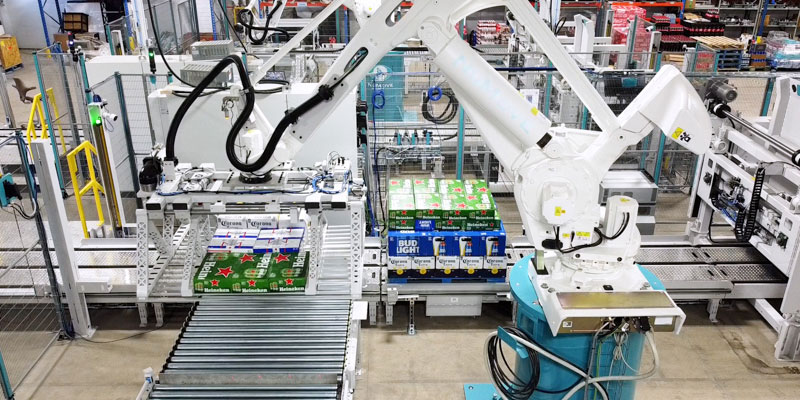Optimizing Mixed-SKU Pallet Preparation
A Comparative Analysis of Semi-Automatic and Robotic Solutions
Guest blog by MHI Member NuMove Robotics & Vision
In the competitive landscape of distribution, the efficiency of order pallet preparation plays a pivotal role in maintaining operational effectiveness. Various approaches to mixed palletizing are now available: semi-automatic, robotic single picking and robotic layer picking. Each method offers distinct advantages, and the choice between them depends on a variety of operational, financial, and logistical factors.
Breaking Down the Leading Approaches
• The semi-automatic approach consists of automatizing the pallet handling while providing operators with an ergonomic workstation to palletize the products with minimal effort. This workstation is on a platform that integrates a stretch wrapper.
• For robotic single picking, the robot picks one product at the time. Different configurations can be used: a robot on a platform with an integrated stretch wrapper, or a floor-level robot. In this later case, product and pallet handling can be performed by conveyors or AMRs.
• Finally, for robotic layer picking, the floor-level robot handles full or partial layers that can include different SKUs.

All options with the robot on the floor can easily have a manual top-off station for slow movers and can include a stretch wrapper downstream.
Comparative Analysis of Approaches
A detailed comparison of the approaches reveals key differences across several characteristics:
• Initial and Operating Costs: Semi-automatic systems generally require a lower initial investment. However, they incur higher ongoing operating costs due to labor dependency. In contrast, robotic systems demand a higher upfront investment but benefit from significantly reduced labor costs over time.
• Labor and Efficiency: Semi-automatic systems rely heavily on human operators, whose performance can vary based on skill, fatigue, and physical limitations. This variability can affect overall efficiency and consistency. Robotic systems offer stable and predictable performance, with the ability to handle repetitive tasks without fatigue.
• Flexibility and Adaptability: Semi-automatic systems excel in environments with frequent product changes. Operators can quickly adapt to new products without requiring software updates. Robotic systems necessitate software adjustments to accommodate new products.
• Speed and Throughput: The speed of semi-automatic systems is inherently variable, influenced by operator productivity. Robotic systems, on the other hand, maintain a constant and reliable speed, ensuring consistent throughput. When integrated with upstream product sequencing systems, robotic solutions can achieve optimal cycle times and load efficiency. A single picking robot achieves throughput comparable to two experienced operators with the semi-automatic solution. As expected, layer palletizing offers higher throughput, up to three times faster than the one obtainable with single picking.
• Product Handling and Sequencing: Semi-automatic systems are well-suited for handling randomly arriving cases without the need for sequencing equipment. Robotic systems achieve maximum efficiency when paired with automated storage and retrieval systems (case AS/RS) that deliver products in a pre-determined sequence.
• Maintenance: Maintenance requirements for semi-automatic systems are minimal and comparable to standard industrial equipment. Robotic systems, while generally low-maintenance, involve more components—such as robotic tools and infeed conveyors—which may increase the likelihood of maintenance needs.
Key Considerations for Strategic Decision-Making
Selecting between a semi-automatic and the various robotic palletizing solutions involves evaluating several interrelated factors:
• Labor Availability: In regions or industries facing labor shortages, robotic systems offer a compelling solution by reducing dependency on manual labor.
• Budget Constraints: Organizations with limited capital may initially favor semi-automatic systems due to their lower cost. However, a comprehensive assessment should consider the total cost of ownership, including long-term labor expenses.
• Production Goals: For operations prioritizing high throughput and production stability, robotic systems are generally more suitable. As mentioned above, layer picking robots offer the best throughput, but are more suited for handling high movers.
• Product Diversity: Businesses handling a changing range of product types and packaging formats may benefit from the flexibility of semi-automatic systems, which can accommodate new items without reconfiguration. Depending on the SKU mix, the robotic solutions combined with manual top-off could also be considered.
• Upstream Integration: The effectiveness of robotic systems is significantly enhanced when integrated with AS/RS systems. While not essential for semi-automatic systems, such integration can still improve overall performance.
Conclusion
Both semi-automatic and robotic mixed-SKU palletizing solutions offer viable paths to enhancing operational efficiency distribution centers and warehouses. The optimal choice depends on a nuanced understanding of the organization’s specific needs, including labor dynamics, budgetary constraints, production targets, and product characteristics. By carefully weighing the advantages and limitations of each approach, distributors can make informed decisions that align with their strategic objectives and operational realities.





